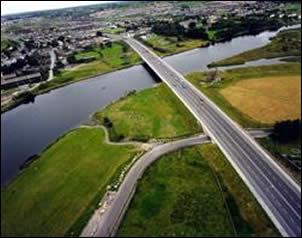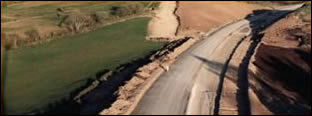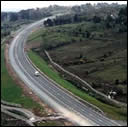|




|

During the Iron Age, roads were built across bogs using
timber. These roads were known as tóchar and the name still survives
in some place names. As these ancient roads fell into disuse, they disappeared
into the bog and thus the original timbers were preserved to modern times.
For many years the primary communication routes for long distance were
by sea and inland waterways as well as by road. Now with continuous investment
in roads and in particular the long distance primary routes, sea transport
is kept as short as possible because land transport is far quicker and
more comfortable. Investment in the National Primary routes and National
Secondary routes is channelled through the National Roads Authority, with
the local County Council or Corporation still playing a major role in
design, land purchase and construction.
|
|
 |
|
|


 |
The Scheme cost IR£24million and included the following elements:
16.5 km of National Primary Route
1.5 km of National Secondary Route
10.0 km of new and improved access
and county roads
Some
of the main statistics for the
project are as follows:
Excavation of 1,500,000 cubic metres of boulder clay
Excavation of 330,000 cubic metres of rock
Excavation of 150,000 cubic metres of soft ground
and replacement with rock. The soft ground was up to 11 m deep in
places
Dealing with 130 separate land
owners.
|
 |
 |
This project, considered as an important contribution
to the infrastructure of Connacht and the North West, was carried
out between 1995 and 1998. This new road, which is partly in Counties
Roscommon and Sligo and runs west of Lough Key and Lough Arrow,
replaces the old N4, which involved a torturous ascent and descent
over the Curlew Mountains. Roscommon County Council were responsible
for project management of the scheme, which was undertaken in part
by direct labour and in part by contract.
An Environmental Impact Statement was carried out for the project.
This was not required by legislation but was undertaken because
of the sensitivity of the landscape through which the road traversed.
Measures undertaken to reduce the visual impact of the new road
included the soiling of rock embankments, which otherwise would
have been evident from 5 km away.



|
|
|

Oranmore Bypass to the Quincentennial Bridge and was
constructed in a number of phases between 1983 and 1996. Approximately
1.0 km of Phase 1 and 0.7 km of Phase 2 of the road was founded on weak
alluvial soils located in the Terryland River basin. The depths of soft
ground varied up to 11 metres and consisted of peat, calcareous marl,
organic clay and inorganic silty clay. The methodology used to construct
the road in these conditions included:
- Placement of geotextile fabric on the undisturbed
ground surface
- Placement of free draining layer of
crushed limestone
- Construction of embankment to a surcharge
height of 0.5 to 1.0 m above the finished road level in order to accelerate
settlement during the construction period
- The maximum recorded settlement was
3.3 m
- Placement of vertical band drains on
a 1.4 m square grid over the entire embankment area in order to accelerate
pore pressure dissipation in the various soil layers
- Installation of a comprehensive instrumentation
system to measure pore water pressure, vertical
settlement and lateral movement
The above methods, to deal with
the weak soils, were first applied in Ireland on the Galway Eastern Approach
Road and the Athlone Relief Road

The bitumen pavements, which are used on almost all Irish roads, consist
of a mixture of aggregate, filler, bitumen and additives. There has been
considerable research in additives over the years in order to produce
a variety of materials to match different requirements. Chemoran, based
in Oranmore and a member of the Cold Chon Group of companies, has been
producing specialised chemical products for the roads industry since the
late 1940's. It now exports to some 56 countries in five continents.
The materials developed and manufactured at the Oranmore plant include
adhesive agents to improve the adhesion between bitumen and stone and
various additives used in the manufacture of many types of cationic bituminous
road emulsions. A research laboratory has been established in conjunction
with NUI, Galway. It is an example of how new products are developed through
collaboration between the private sector and third level institutions
and involving scientists and engineers.l institutions and involving scientists
and engineers.

In the year 2000, design teams are in place for a number
of significant roads projects in the West of Ireland and the National
Development Plan, 1999 includes for major expenditure on roads over the
first decade of the new millennium. Implementation of this roads programme
will improve connectivity between the West and the rest of country and
presents opportunities for engineers in the design and construction stages.

|
|



